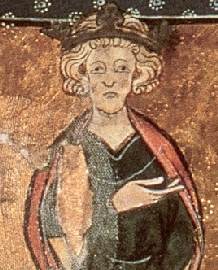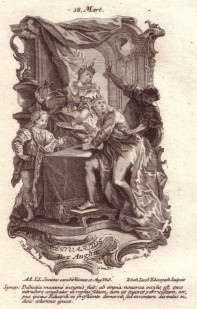Edward the Confessor
2007 Schools Wikipedia Selection. Related subjects: British History 1500 and before (including Roman Britain); Monarchs of Great Britain; Religious figures and leaders
| Saint Edward II, the Confessor | ||
|---|---|---|
| King of England | ||
 |
||
| Reign | [June 8 1042 not crowned till April 3], 1043 – 4/5 January 1066 | |
| Born | c. 1002– 1005 | |
| Islip, Oxfordshire, England | ||
| Died | January 4, 1066 | |
| Buried | Westminster Abbey, Westminster, England | |
| Predecessor | Harthacanute | |
| Successor | Harold Godwinson | |
| Consort | Edith of Wessex | |
| Father | Ethelred the Unready | |
| Mother | Emma of Normandy{ | |
St Edward the Confessor or Eadweard III (c. 1004 – 4 January 1066), son of Ethelred the Unready, was the penultimate Anglo-Saxon King of England and the last of the House of Wessex, ruling from 1042 until his death. His reign marked the continuing disintegration of royal power in England and the aggrandisement of the great territorial earls, and it foreshadowed the country's later connection with Normandy, whose duke William I was to supplant Edward's successors Harold Godwinson and Edgar Ætheling as England's ruler.
He succeeded his half-brother Harthacanute, who had successfully regained the throne of England after being dispossessed by their mutual step-brother, Harold Harefoot; Edward and his brother Alfred the Aetheling, both sons of Emma of Normandy by Ethelred the Unready, had previously failed to depose Harold in 1036.
Edward was canonised in 1161 and is considered a saint by the Roman Catholic Church, which regards Edward the Confessor as the patron saint of kings, difficult marriages, and separated spouses. From the reign of Henry II of England to 1348 he was considered the patron saint of England, and he has remained the patron saint of the Royal Family.
Early life
In 1013, Edward and his brother Alfred were taken to Normandy by their mother Emma, sister of Normandy's Duke Richard II, to escape the Danish invasion of England. Edward developed an intense personal piety in his quarter-century of Norman exile, during his most formative years, while England formed part of a great Danish empire. His familiarity with Normandy and its leaders would also influence his later rule.
After an abortive attempt with Alfred in 1036 to displace their step-brother Harold Harefoot from the throne, Edward returned to Normandy; Alfred, however, was captured and killed by Godwin, Earl of Wessex. This murder of his brother is thought to be the source of much of his later hatred for the Earl and played a major part in the reason for his banishment in autumn 1051; Edward said that the only way in which Godwin could be forgiven was if he brought back the murdered Alfred, an impossible task.
The Anglo-Saxon lay and ecclesiastical nobility invited Edward back to England in 1041; this time he became part of the household of his half-brother Harthacanute (son of Emma and Canute), and according to the Anglo-Saxon Chronicle was sworn in as king alongside him. Following Harthacanute's death on 8 June 1042, Edward ascended the throne. The Anglo-Saxon Chronicle indicates the popularity he enjoyed at his accession — "before Harthacanute was buried, all the people chose Edward as king in London". Edward was crowned at the cathedral of Winchester, the royal seat of the West Saxons on 3 April 1043.
When Edward died in 1066 he had no son to take over the throne so there was a problem as three people claimed the throne of England.
Edward's Reign
Edward's reign was marked by peace and prosperity, but effective rule in England required coming to terms with three powerful earls: Godwin, Earl of Wessex, who was firmly in control of the thegns of Wessex, which had formerly been the heart of the Anglo-Saxon monarchy; Leofric, Earl of Mercia, whose legitimacy was strengthened by his marriage to Lady Godiva, and in the north, Siward, Earl of Northumbria. Edward's sympathies for Norman favourites frustrated Saxon and Danish nobles alike, fuelling the growth of anti-Norman opinion led by Godwin, who had become the king's father-in-law in 1045. The breaking point came over the appointment of an archbishop of Canterbury: Edward rejected Godwin's man and appointed the bishop of London, Robert of Jumièges, a trusted Norman.
Matters came to a head over a bloody riot at Dover between the townsfolk and Edward's kinsman Eustace, count of Boulogne. Godwin refused to punish them, Leofric and Siward backed the King, and Godwin and his family were all exiled in September 1051. Queen Edith was sent to a nunnery at Wherwell. Earl Godwin returned with an armed following a year later, however, forcing the king to restore his title and send away his Norman advisors. Godwin died in 1053 and the Norman Ralph the Timid received Herefordshire, but his son Harold accumulated even greater territories for the Godwins, who held all the earldoms save Mercia after 1057. Harold led successful raiding parties into Wales in 1063 and negotiated with his inherited rivals in Northumbria in 1065, and in January 1066, upon Edward's death, he was proclaimed king.
Aftermath
The details of the succession have been widely debated: the Norman position was that William had been designated the heir, and that Harold had been publicly sent to him as emissary from Edward, to apprise him of Edward's decision. Harold's party asserted that the old king had made a deathbed bestowal of the crown on Harold. However, Harold was approved by the Witenagemot who, under Anglo-Saxon law, held the ultimate authority to convey kingship.
Edward had married Godwin's daughter Edith on 23 January 1045, but the union was childless. The reason for this is the subject of much speculation. Possible explanations include Edward, having taken vow of chastity, considering the union a spiritual marriage, the age difference between Edward and Edith engendering a filial rather than spousal relationship, Edward's antipathy toward Edith's father (Barlow 1997), or infertility.
Edward's nearest heir would have been his nephew Edward the Exile, who was born in England, but spent most of his life in Hungary. He had returned from exile in 1056 and died not long after, in February the following year. So Edward made his great nephew Edgar Atheling his heir. But Edgar had no secure following among the earls: the resultant succession crisis on Edward's death without a direct "throneworthy" heir — the "foreign" Edgar was a stripling of fourteen — opened the way for Harold's coronation and the invasions of two effective claimants to the throne, the unsuccessful invasion of Harald Hardrada in the north and the successful one of William of Normandy.
William of Normandy, who had visited England during Godwin's exile, claimed that the childless Edward had promised him the succession to the throne, and his successful bid for the English crown put an end to Harold's nine-month kingship following a 7000-strong Norman invasion. Edgar Ætheling was elected king by the Witan after Harold's death but was brushed aside by William. Edward, or more especially the mediæval cult which would later grow up around him under the later Plantagenet kings, had a lasting impact on English history. Westminster Abbey was founded by Edward between 1045 and 1050 on land upstream from the City of London, and was consecrated on 28 December 1065. Centuries later, Westminster was deemed symbolic enough to become the permanent seat of English government under Henry III. The Abbey contains a shrine to Edward which was the centrepiece to the Abbey's redesign during the mid-thirteenth century. In 2005, Edward's remains were found beneath the pavement in front of the high altar. His remains had been moved twice in the 12th and 13th centuries, and the original tomb has since been found on the central axis of the Abbey in front of the original high altar.
Historically, Edward's reign marked a transition between the 10th century West Saxon kingship of England and the Norman monarchy which followed Harold's death. Edward's allegiances were split between England and his mother's Norman ties. The great earldoms established under Canute grew in power, while Norman influence became a powerful factor in government and in the leadership of the Church.
It was during the reign of Edward that some features of the English monarchy familiar today were introduced. Edward is regarded as responsible for introducing the royal seal and coronation regalia. Also under Edward, a marked change occurred in Anglo-Saxon art, with continental influences becoming more prominent (including the "Winchester Style" which had become known in the 10th century but prominent in the 11th), supplanting Celtic influences prominent in preceding painting, sculpture, calligraphy and jewellery (see Benedictional of St. Æthelwold for an example of the Winchester Style). His crown is believed to have survived until the English Civil War when Oliver Cromwell allegedly ordered it to be destroyed. Gold from it is understood to have been integrated into the St. Edward's Crown, which has been used in coronations since Charles II of England in 1661.
Canonization
When Henry II came to the throne in 1154, he united in his person at last the Saxon and Norman royal lines. To reinforce this new warrant of authenticity, the cult of King Edward the Confessor was promoted. Osbert de Clare was a monk of Westminster, elected Prior in 1136, and remembered for his lives of saints Edmund, Ethelbert and Edburga, in addition to one of Edward, in which the king was represented as a holy man, reported to have performed several miracles and to have healed people by his touch. Osbert was, as his surviving letters demonstrate, an active ecclesiastical politician, and went to Rome to advocate the cause for Edward to be declared a saint, successfully securing his canonisation by Pope Alexander III in 1161. In 1163, the newly sainted king's remains were enshrined in Westminster Abbey with solemnities presided over by Thomas Becket, Archbishop of Canterbury. On this occasion the honour of preparing a sermon was given to Aelred, the revered Abbot of Rievaulx, to whom is generally attributed the vita in Latin, a hagiography partly based on materials in an earlier vita by Osbert de Clare and which in its turn provided the material for a rhymed version in octasyllabic Anglo-Norman, possibly written by the chronicler Matthew Paris.
At the time of Edward's canonisation, saints were broadly categorised as either martyrs or confessors: martyrs were people who had been killed for their faith, while confessors were saints who had died natural deaths. Edward was accordingly styled Edward the Confessor, partly to distinguish him from his canonised predecessor Edward the Martyr.
The Roman Catholic Church regards Edward the Confessor as the patron saint of kings, difficult marriages, and separated spouses. After the reign of Henry II Edward was considered the patron saint of England until 1348 when he was replaced in this role by St. George. He remained the patron saint of the Royal Family.
Edward's reign is memorialized in an eight panel stained glass window within St Laurence Church, Ludlow, England.
In the Arts
Referenced by characters in Shakespeare's play, The Tragedy of Macbeth, as the saintly king of England.
